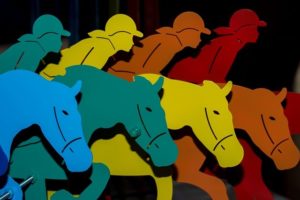What are the Queen’s racing colours?
Her Majesty Queen Elizabeth II has enjoyed a lifelong passion for horse racing. Indeed, between her coronation in 1953 and 2020, when she was forced to stay at home because of Covid-19 restrictions, the Queen never missed a day of Royal Ascot.
Her officially registered racing colours consist of a purple jacket with gold braid, red sleeves and a black velvet cap with a gold fringe, as previously used by her great grandfather King Edward VII and, before that, by the later King George IV during his years as Prince Regent. Racing colours are currently supplied to the Queen by Newmarket-based Gibson Saddlers, which was granted a Royal Warrant of Appointment by Her Late Majesty Queen Elizabeth The Queen Mother in 1932.
All told, the Queen has seen the famous Royal silks carried to victory at Royal Ascot on 24 separate occasions. The first was in 1953, when Choir Boy won the Royal Hunt Cup, but arguably the most memorable came in 2013, when Estimate won the historic Gold Cup. John Warren, Bloodstock and Racing Advisor to the Queen, later wrote, ‘No reigning monarch had won the Gold Cup and it gave Her Majesty great pleasure in achieving an ambition to breed such a great horse of true stamina and grit.’
 The term ‘steeplechase’ was coined in the late eighteenth or early nineteenth century to describe an early form of point-to-point racing, in which the ‘course’ – which was, in fact, open countryside – started and finished at a church steeple. In fact, the first recorded race of this type was held in County Cork, Ireland in 1752. More recently, on enclosed racecourses, the original, natural obstacles were replaced with artificial fences and ditches, but the name endured. Nowadays, steeplechases are run over advertised distances between two miles and four miles and two-and-a-half furlongs.
The term ‘steeplechase’ was coined in the late eighteenth or early nineteenth century to describe an early form of point-to-point racing, in which the ‘course’ – which was, in fact, open countryside – started and finished at a church steeple. In fact, the first recorded race of this type was held in County Cork, Ireland in 1752. More recently, on enclosed racecourses, the original, natural obstacles were replaced with artificial fences and ditches, but the name endured. Nowadays, steeplechases are run over advertised distances between two miles and four miles and two-and-a-half furlongs.